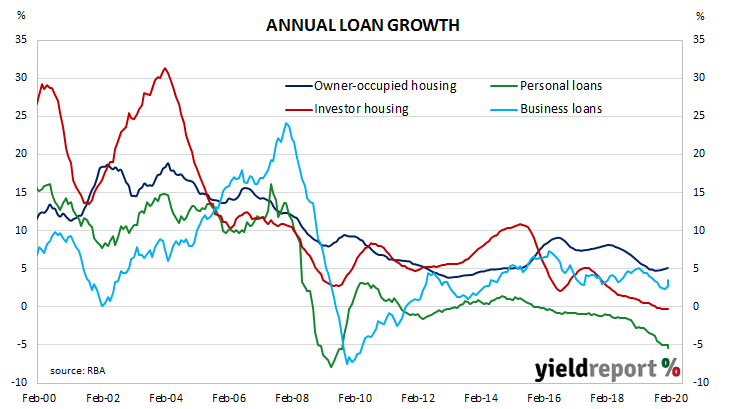The pace of lending to the non-bank private sector by financial institutions in Australia has been trending down since October 2015. It appeared to have stabilised in the September quarter of 2018 but the annual growth rate then continued to deteriorate through 2019, despite some optimism emerging in the housing market following the re-election of the Coalition Government in May of that year.
While senior RBA officials would like business lending to increase, those same officials would also like households to reduce debt. In early 2020, RBA Governor Philip Lowe publicly stated the cash rate had been reduced in part to assist households to set aside funds to repay debt.
According to the latest RBA figures, private sector credit grew by +0.4% in February, above the +0.3% increase which had been expected but in line with January’s +0.4% increase after it was revised up from 0.3%. The annual growth rate moved higher, from January’s revised annual rate of 2.6% to 2.8%.
The increase over the month was predominantly driven by increased business lending, with real estate investors also playing a significant part. Personal lending and lending to owner-occupiers both increased modestly. Westpac senior economist Andrew Hanlan said, “Credit began 2020 on a slightly better note, expanding by 0.4% in both January and February, the best two month period since August-September 2018.” ANZ economist Hayden Dimes agreed but noted the change in conditions after the end of February. “Despite the pick-up this quarter so far, we anticipate from next quarter onwards overall credit growth will slow and then turn negative.”
Westpac senior economist Andrew Hanlan said, “Credit began 2020 on a slightly better note, expanding by 0.4% in both January and February, the best two month period since August-September 2018.” ANZ economist Hayden Dimes agreed but noted the change in conditions after the end of February. “Despite the pick-up this quarter so far, we anticipate from next quarter onwards overall credit growth will slow and then turn negative.”
Local Treasury bonds yields fell a little. By the end of the Australian trading day, the 3-year Treasury bond yield had slipped 1bp to 0.27%, 2bps above the RBA target rate of 0.25%. The 10-year yield lost 2bps to 0.74% while the 20-year yield finished 3bps lower at 1.43%.

